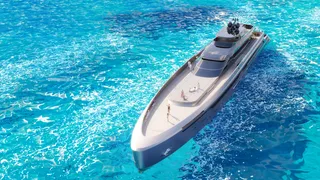Italian studio MASK architects has revealed further details of its hydrogen-powered superyacht design, developed under the codename ONYX H2-B0 85.
The 85-metre project would combine hydrogen production through electrolysis with hydroelectric turbines, creating a "unique solution" for sustainable power generation during short cruises. The turbines would efficiently capture kinetic energy from the surrounding water for onboard hydrogen generation, eliminating the need for large fuel reserves and reducing reliance on fossil fuels for an eco- and cost-friendly build.
The produced hydrogen can be used as a fuel source for various onboard purposes, including power for engines, generators or fuel cells. It can also be stored as a backup power source.
A long, narrow profile characterises the project (with design cues evidently taken from sport yachts), while new renderings reveal moody, futuristic living spaces said to incorporate "sumptuous" and "eco-conscious" materials. Other leisure highlights include a spacious, uncluttered foredeck for sunbathing, al fresco dining on the sundeck and an aft deck swimming pool.
How does seawater electrolysis lead to hydrogen propulsion?
- A seawater intake system is installed to draw seawater from the surrounding environment. This system includes a pump and filters to ensure that the seawater used is free from contaminants that could damage the electrolysis equipment.
- The seawater is treated for impurities like salt, minerals and other particles. This is done via filtration and desalination systems.
- The electrolysis chamber contains two electrodes (positive and negative) which are connected to a power source and immersed in this pre-treated seawater.
- An electrical current is passed through the seawater, which causes the water molecules to break apart into hydrogen and oxygen gases.
- The hydrogen forms at the cathode (negative electrode) and separated from the oxygen gas produced at the anode (positive electrode). It is then stored in a tank and used as a fuel source.
"It's important to note that while producing hydrogen from seawater is feasible, it requires specialised equipment and expertise," noted the studio. "Collaborating with experts in marine engineering and hydrogen technology would be essential [for this project]."
Hydrogen propulsion is a hot topic in the yachting industry, with Port Vauban and the Port of Amsterdam joining efforts on the implementation of hydrogen infrastructure following the delivery of the 118.8-metre Breakthrough. The groundbreaking Feadship build is the world's first hydrogen-powered superyacht and will be debuting at this year's Monaco Yacht Show.
Read More/The largest yachts attending the Monaco Yacht Show 2025
